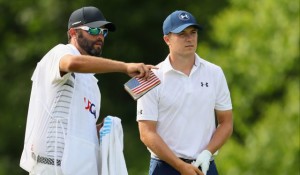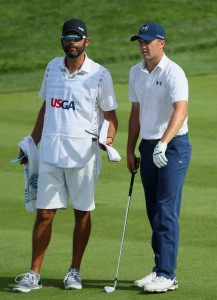Jordan Spieth’s week at Oakmont didn’t go as he would have liked. It started with the multiple rain delays on Thursday as Spieth had an early tee time. He was one of the players that had to deal with the start, stop, start, stop action on a day that tested players and fans alike.
When the weather settled down and Spieth had his chance to defend his U.S. Open title his game didn’t respond. While many players were able to take advantage of a softened Oakmont and scrape together sub-par rounds he could not.
But that doesn’t mean he wasn’t the center of attention for a good portion of the week. Fox Sports had a few video packages on him and we got to see them often and when you are The Golden Child of American Golf you’re bound to get a ton of camera time.
But much of the attention on Spieth this week focused on his pace of play, or lack thereof.
Spieth has many admirable qualities. In addition to his skills with the clubs he handles the fans, the press and being a multimillionaire at twenty two with the skill and aplomb of a diplomat.
But playing fast or as fast as the rest of the tour isn’t one of his strong points. Simply put he is a slow player.
We have all seen it numerous times on television. The chit chat with caddie Michael Greller, the yardage book check and double and triple check, the towel grabbing, the back off after back off and so on and so on. It all adds up on each and every shot.
On Thursday at Oakmont I sat in the bleachers waiting for Spieth and his group to come by the second and fourth holes as we had a grand view of those holes. We could see back to the first green as Spieth, Bryson DeChambeau and Zach Johnson were putting out. The group ahead of them were already done with the second hole and in the third fairway. There was an entire hole and a half open ahead of them.
Granted, Dechambeau had a lost ball off the first tee but the group had already been put on the clock when they finished the eighteenth hole.
As they played the second hole, Johnson was nearer the green than Spieth but went ahead and hit before Spieth which resulted in both Spieth and Greller shrugging their shoulders as if the say “what’s up?” He obviously was trying to make up some time, and rightfully so.
That group is a slow moving one as all three of them are notorious for relying on input from their caddies and those conversations can get quite lengthy.
True, my research on Spieth is limited to television and the half few times I have seen him in person.
But add to that Golf Digest’s Joel Beall who set about to prove if those U.S. Open players are actually really that slow.
Jordan Spieth probably isn’t helping matters. The two-time major winner’s, ahem, methodical ways have come under scrutiny before, as he was famously penalized for falling behind at a European Tour event earlier this year. At Oakmont, his groups were routinely a hole behind.
But is Spieth really that slow, or does his constant presence on television merely make his pace seem worse than it is? This matter required investigation, which is why my boss kicked me out of the friendly, air-conditioned confines of the media center into the Western Pennsylvania heat to find out.
With only two groups ahead and on the sixth hole of their rounds, Spieth, Jason Dufner and Spencer Levin were already an entire hole behind. I walked back to the 15th hole to see what the holdup was and soon found my answer. Facing a 44-foot putt for birdie, Spieth took two minutes and 49 seconds from placing his ball down (Duf had a heck of a bunker shot before Spieth’s turn) to his stroke. In that span, he walked to the other side of his line, checked his notes, kneeled down, fixed marks by his ball, went to a third perspective, backed off, stood behind the ball for 25 seconds and lingered over his Titleist for what seemed like an eternity. He missed, and his three-footer for par — which he converted — still took close to 90 seconds to make.
Spieth wasn’t the only guilty party of this pairing. Levin was recorded at 82 seconds, a mark filled with a ton of time behind the ball, a back off and rechecking a different angle.
They were a tad quicker on the 16th tee box — Duf didn’t take a practice swing, with a tee-to-contact time of 28 seconds — and even Spieth, who made four quick, abbreviated practice hacks and multiple wags, got out in 38 seconds. (Levin, perhaps upset that he failed to grab a birdie on the 15th, took 14 seconds, which I believe included a confusion about yardage followed by an “Aw, screw it” shrug.)
Unfortunately, the group ran into the same issue on the green. Dufner’s first putt took 11 seconds, and Levin, even with multiple practice putts, completed his in 19 seconds. On the other end of the spectrum was Spieth, who went to both sides of the line, set up shop behind the ball for 30 seconds before his stroke for a total time of 84 seconds.
Taking an extra 90 seconds on the green seems trivial, but if that duration takes place on every hole, that’s 30 minutes behind schedule. And the group was put on the clock on the 18th hole — the second instance for Spieth this tournament.
I know is not a scientific, double blind study backed by the USGA but enough is enough.
Spieth plays slow.
It bugs the hell out of me but…and it’s a big but: He is the biggest thing in American golf since Tiger Woods. And he’s likable, polite, kind, and mature and the kind of kid you want your daughter to bring home.
So the tour and most everyone else will deal with the long rounds and the delays because even with the ten minute pre-shot routine he is still the best thing to happen in American golf in a long time.
I just wish he would play faster.
